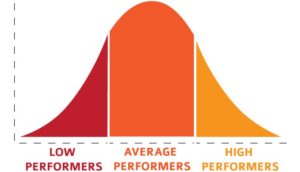Previously, we use normal referenced test (ujian rujukan norma – Bell-shaped graph) to assess the students’ assessment. Now, when we move to OBE – we are hardly to get bell-shaped graph anymore. This is because formative assessment use criterion reference test. It is like measuring people’s height – most of Malaysian will be between 1.5-1.7 meters height. But it is still valid for summative evaluation (e.g final exam) to get the bell-shaped graph again.

| Measurement scales | Essential features | Zero point | Example |
| Nominal – Hanya untuk nama sahaja – takde nilai nombor tersebut |
Unordered categories | Arbitrary (meaningless) | Course code at university, postcode, jersey number, races |
| Ordinal – Number ada pangkat (order) – tidak boleh mencari nilai purata |
Ordered categories | Arbitrary | Ribbons in a talent contest, a student’s percentile rank, Liekert Scale |
| Interval – Equal units along the scale |
Equal units along the scale. | Arbitrary | Fahrenheit, temperature |
| Ratio -skala yang paling banyak untuk memberi information |
Equal units | Absolute meaning (means tahu mana nilai 0) | Kelvin temperature, disctance in kilometre. |
